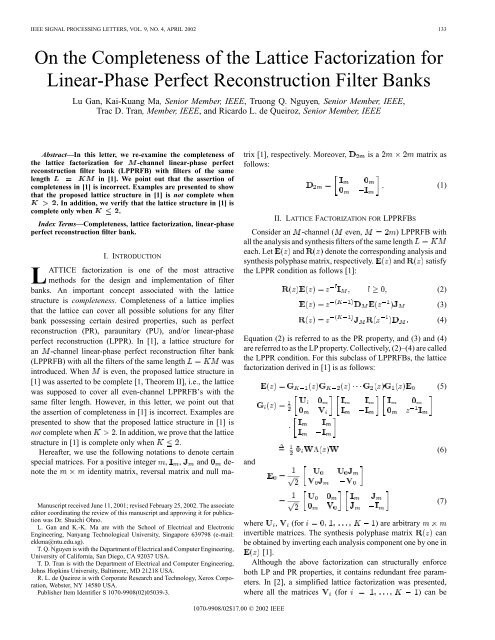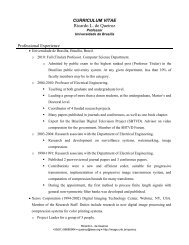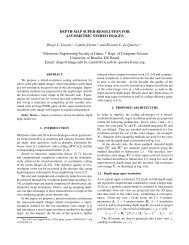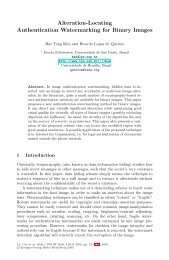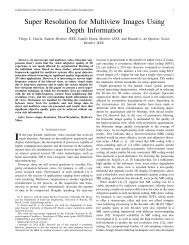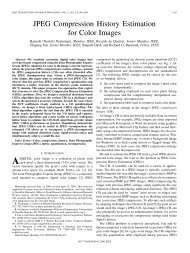IEEE SIGNAL PROCESSING LETTERS, VOL. 9, NO. 4 ... - IEEE Xplore
IEEE SIGNAL PROCESSING LETTERS, VOL. 9, NO. 4 ... - IEEE Xplore
IEEE SIGNAL PROCESSING LETTERS, VOL. 9, NO. 4 ... - IEEE Xplore
Create successful ePaper yourself
Turn your PDF publications into a flip-book with our unique Google optimized e-Paper software.
<strong>IEEE</strong> <strong>SIGNAL</strong> <strong>PROCESSING</strong> <strong>LETTERS</strong>, <strong>VOL</strong>. 9, <strong>NO</strong>. 4, APRIL 2002 133<br />
On the Completeness of the Lattice Factorization for<br />
Linear-Phase Perfect Reconstruction Filter Banks<br />
Lu Gan, Kai-Kuang Ma, Senior Member, <strong>IEEE</strong>, Truong Q. Nguyen, Senior Member, <strong>IEEE</strong>,<br />
Trac D. Tran, Member, <strong>IEEE</strong>, and Ricardo L. de Queiroz, Senior Member, <strong>IEEE</strong><br />
Abstract—In this letter, we re-examine the completeness of<br />
the lattice factorization for -channel linear-phase perfect<br />
reconstruction filter bank (LPPRFB) with filters of the same<br />
length = in [1]. We point out that the assertion of<br />
completeness in [1] is incorrect. Examples are presented to show<br />
that the proposed lattice structure in [1] is not complete when<br />
2. In addition, we verify that the lattice structure in [1] is<br />
complete only when 2.<br />
Index Terms—Completeness, lattice factorization, linear-phase<br />
perfect reconstruction filter bank.<br />
I. INTRODUCTION<br />
LATTICE factorization is one of the most attractive<br />
methods for the design and implementation of filter<br />
banks. An important concept associated with the lattice<br />
structure is completeness. Completeness of a lattice implies<br />
that the lattice can cover all possible solutions for any filter<br />
bank possessing certain desired properties, such as perfect<br />
reconstruction (PR), paraunitary (PU), and/or linear-phase<br />
perfect reconstruction (LPPR). In [1], a lattice structure for<br />
an -channel linear-phase perfect reconstruction filter bank<br />
(LPPRFB) with all the filters of the same length was<br />
introduced. When is even, the proposed lattice structure in<br />
[1] was asserted to be complete [1, Theorem II], i.e., the lattice<br />
was supposed to cover all even-channel LPPRFB’s with the<br />
same filter length. However, in this letter, we point out that<br />
the assertion of completeness in [1] is incorrect. Examples are<br />
presented to show that the proposed lattice structure in [1] is<br />
not complete when . In addition, we prove that the lattice<br />
structure in [1] is complete only when .<br />
Hereafter, we use the following notations to denote certain<br />
special matrices. For a positive integer , , and denote<br />
the identity matrix, reversal matrix and null ma-<br />
trix [1], respectively. Moreover, is a matrix as<br />
follows:<br />
II. LATTICE FACTORIZATION FOR LPPRFBS<br />
Consider an -channel ( even, ) LPPRFB with<br />
all the analysis and synthesis filters of the same length<br />
each. Let and denote the corresponding analysis and<br />
synthesis polyphase matrix, respectively. and satisfy<br />
the LPPR condition as follows [1]:<br />
Equation (2) is referred to as the PR property, and (3) and (4)<br />
are referred to as the LP property. Collectively, (2)–(4) are called<br />
the LPPR condition. For this subclass of LPPRFBs, the lattice<br />
factorization derived in [1] is as follows:<br />
and<br />
(1)<br />
(2)<br />
(3)<br />
(4)<br />
(5)<br />
(6)<br />
Manuscript received June 11, 2001; revised February 25, 2002. The associate<br />
editor coordinating the review of this manuscript and approving it for publication<br />
was Dr. Shuichi Ohno.<br />
L. Gan and K.-K. Ma are with the School of Electrical and Electronic<br />
Engineering, Nanyang Technological University, Singapore 639798 (e-mail:<br />
ekkma@ntu.edu.sg).<br />
T. Q. Nguyen is with the Department of Electrical and Computer Engineering,<br />
University of California, San Diego, CA 92037 USA.<br />
T. D. Tran is with the Department of Electrical and Computer Engineering,<br />
Johns Hopkins University, Baltimore, MD 21218 USA.<br />
R. L. de Queiroz is with Corporate Research and Technology, Xerox Corporation,<br />
Webster, NY 14580 USA.<br />
Publisher Item Identifier S 1070-9908(02)05039-3.<br />
where , (for ) are arbitrary<br />
invertible matrices. The synthesis polyphase matrix can<br />
be obtained by inverting each analysis component one by one in<br />
[1].<br />
Although the above factorization can structurally enforce<br />
both LP and PR properties, it contains redundant free parameters.<br />
In [2], a simplified lattice factorization was presented,<br />
where all the matrices (for ) can be<br />
(7)<br />
1070-9908/02$17.00 © 2002 <strong>IEEE</strong>
134 <strong>IEEE</strong> <strong>SIGNAL</strong> <strong>PROCESSING</strong> <strong>LETTERS</strong>, <strong>VOL</strong>. 9, <strong>NO</strong>. 4, APRIL 2002<br />
replaced by the identity matrix without loss of generality.<br />
That is, all in (6) can be substituted by<br />
The simplified expression in (8) provides a much more efficient<br />
way for both design and implementation of LPPRFB.<br />
Later, we will use it to analyze the completeness of the lattice<br />
factorization.<br />
III. ON THE COMPLETENESS OF THE LATTICE FACTORIZATION<br />
A. Review of the Original Proof<br />
In [1, Th. II], it was stated that the lattice factorization in (5)<br />
is complete, i.e., it covers all possible solutions of even-channel<br />
LPPRFBs with filter length of each. However, in the<br />
following, we shall show that this assertion is incorrect. To this<br />
end, let us briefly review the original incorrect proof in [1].<br />
The proof of completeness relies on the existence of a<br />
building block that can reduce the order of<br />
by 1 at a time while retaining the LPPR property of the<br />
reduced-order<br />
. A critical step in the<br />
proof is the causality of the factorization, i.e., there always<br />
exist invertible matrices and that can produce<br />
a causal . Let and<br />
, the proof of causality<br />
is equivalent to showing that there always exist two invertible<br />
matrices and such that [1, (A.4)]<br />
(8)<br />
where and are the upper and lower submatrices of<br />
with size of each. Substituting (11) into (10) yields<br />
(12)<br />
which indicates that can be represented through a linear<br />
transform of . In other words, (10) is satisfied if and only<br />
if the row vectors of and span the same space, the condition<br />
rank Null<br />
alone cannot guarantee the existence<br />
of in (10). Hence, the original proof of completeness<br />
in [1] is incorrect and consequently, the completeness of<br />
the lattice factorization needs to be re-studied. In the following,<br />
through counter examples, we will show that the factorization<br />
is not complete when . Then, we prove that the factorization<br />
is complete when .<br />
B.<br />
Actually, (12) is a very strong restriction. When ,an<br />
LPPRFB can exist even if (12) does not hold. To see this more<br />
clearly, we first provide a counter example for . Based<br />
on it, other counter examples can be generated for .<br />
1) : A counter example for is as follows. For<br />
instance, when , let and be chosen as<br />
and<br />
(13)<br />
(9)<br />
In [1], it is presumed that (9) is satisfied if rank ,<br />
since, in that case, the dimension of the null space of is<br />
larger than or equal to , i.e., rank Null ,in<br />
which Null denotes the null space of . It is assumed<br />
in [1] that under this condition, it is possible to choose<br />
linearly independent vectors from ’s null space to serve as<br />
.<br />
As previously mentioned, in (6) can be replaced by<br />
in (8) without loss of generality. Thus, we can rephrase<br />
the above assumption in the simplified factorization as follows.<br />
If rank Null<br />
, there always exist an invertible<br />
matrix such that<br />
However, such assumption is not true.<br />
Now, express as<br />
(10)<br />
(11)<br />
(14)<br />
One can verify that and satisfy<br />
(15)<br />
(16)<br />
(17)<br />
That is, and satisfy the LPPR condition with ,<br />
and in (2)–(4). Moreover, from (13), it is easy<br />
to see that rank<br />
. However, in this example,<br />
the basis vector of is , while the basis vector of<br />
is<br />
. They do not span the same space. Thus,<br />
does not exist. As a result, can not be expressed in terms of<br />
(5). This example means that the factorization cannot cover all<br />
the solutions when . Based on it, we can also find other<br />
counter examples for as follows.
GAN et al.: ON THE COMPLETENESS OF THE LATTICE FACTORIZATION 135<br />
2) : When is odd ( , ), let<br />
the corresponding analysis bank<br />
and<br />
synthesis bank<br />
be chosen as<br />
that<br />
and<br />
. However, from (22), one can compute<br />
and (18)<br />
in which and are the same as in (13) and (14), respectively.<br />
From (15)–(18), one can derive that<br />
(27)<br />
(19)<br />
(20)<br />
(21)<br />
In other words, and satisfy the LPPR condition<br />
in (2)–(4) with , and . But<br />
since , for the same reason as explained in the previous<br />
example, can not be represented through (5), either.<br />
On the other hand, when is even ( ,<br />
), let the analysis bank and synthesis<br />
bank<br />
be chosen as<br />
and<br />
diag<br />
diag (22)<br />
where and are defined in (18) with taking the<br />
same value. Since and satisfy the PR property in<br />
(2), it is easy to verify that and also satisfy the PR<br />
property as follows:<br />
diag<br />
Moreover, noticing the fact that<br />
diag<br />
(23)<br />
diag diag (24)<br />
satisfies the LP prop-<br />
and using (20), we can derive that<br />
erty as follows:<br />
diag<br />
diag<br />
(25)<br />
Let and denote the first two rows and the last two rows<br />
of , respectively, i.e.,<br />
and (28)<br />
Clearly, the row vectors of and do not span the same<br />
space. Therefore, cannot be represented in terms of (5),<br />
either.<br />
From the above counter examples, we can conclude that the<br />
lattice factorization in (5) is not complete for .<br />
C.<br />
Now, let us study the case when . It is easy to see that<br />
when , the factorization is complete [1]. Next, we will<br />
prove that the factorization is also complete when .<br />
Similarly, as in [1], we have to show the existence of a<br />
such that<br />
corresponds to an<br />
LPPRFB with . Since the preservation of LPPR property<br />
and order reduction property have been verified in [1], we need<br />
only to prove causality. The proof of completeness for<br />
is accomplished if we can verify the existence of an invertible<br />
matrix satisfying (10), or equivalently, (12). Just as in [1],<br />
for simplicity of exposition, denote<br />
and<br />
. The LP condition implies that [1]<br />
and (29)<br />
Equivalently, and (for , 1) should take the following<br />
forms:<br />
and<br />
(30)<br />
(31)<br />
in which and are, respectively, the upper and lower submatrices<br />
of with size of each, while and<br />
are, respectively, the left and right submatrices of with size<br />
of each. Besides, the PR property<br />
leads to<br />
(32)<br />
satisfies the LP prop-<br />
In a similar way, one can verify that<br />
erty also<br />
(26)<br />
Equations (23), (25), and (26) mean that and satisfy<br />
the LPPR condition in (2)–(4) with ,<br />
from which one can derive that<br />
and<br />
With (29), one can obtain<br />
(33)<br />
(34)<br />
(35)
136 <strong>IEEE</strong> <strong>SIGNAL</strong> <strong>PROCESSING</strong> <strong>LETTERS</strong>, <strong>VOL</strong>. 9, <strong>NO</strong>. 4, APRIL 2002<br />
Substituting (30) and (31) into (33) yields<br />
(36)<br />
As for an matrix and a matrix , rank ,<br />
rank rank , thus,<br />
rank rank rank<br />
and<br />
rank (37)<br />
Besides, for an matrix , rank , hence,<br />
rank rank rank<br />
and<br />
rank (38)<br />
Based on (37) and (38), we can deduce that<br />
rank rank rank rank<br />
(39)<br />
which means that all the rows of and must be independent,<br />
and all the columns of and are independent,<br />
too. Hence,<br />
rank and rank (40)<br />
Furthermore, applying Sylvester’s rank inequality [3] to (35)<br />
results in<br />
rank rank rank<br />
rank rank (41)<br />
From (40) and (41), we have<br />
rank rank (42)<br />
Together, (39) and (42) mean that the row vectors of and<br />
must span the same space. Hence, can be represented<br />
through a linear transform of . That is, there always exists an<br />
invertible matrix such that (12), or equivalently, (10) exists,<br />
which further means that causality is met.<br />
From the above discussions, Theorem II in [1] should be<br />
amended as follows.<br />
Theorem 1: For any -channel ( even) LPPRFB with all<br />
the analysis and synthesis filters of length each, the<br />
corresponding analysis polyphase matrix can always be<br />
factored as in (5).<br />
IV. CONCLUSION<br />
We have re-examined the completeness of the lattice factorization<br />
for -channel ( even) LPPRFB with all the filters of<br />
the same length in [1]. We point out that the original<br />
proof of completeness contains an incorrect assumption.<br />
Through counter examples, we show that the factorization is not<br />
complete for . Additionally, we prove that the factorization<br />
is complete when . The complete factorization of the<br />
general ( ) case is still an open problem.<br />
REFERENCES<br />
[1] T. D. Tran, R. L. de Queiroz, and T. Q. Nguyen, “Linear-phase perfect<br />
reconstruction filter bank: Lattice structure, design, and application in<br />
image coding,” <strong>IEEE</strong> Trans. Signal Processing, vol. 48, pp. 133–147,<br />
Jan. 2000.<br />
[2] L. Gan and K.-K. Ma, “A simplified lattice factorization for linear-phase<br />
perfect reconstruction filter bank,” <strong>IEEE</strong> Signal Processing Lett., vol. 8,<br />
pp. 207–209, July 2001.<br />
[3] F. R. Gantmacher, The Theory of Matrices. New York: Chelsea, 1977.


